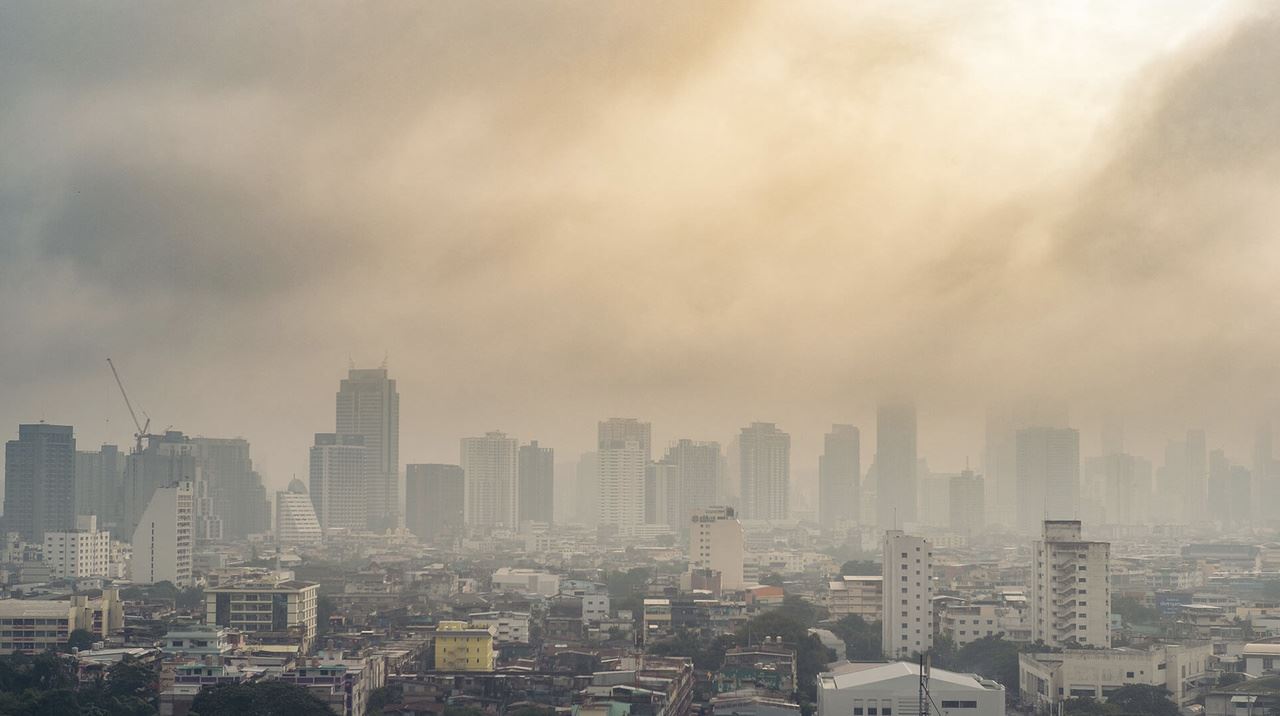Is there a bush fire in your area? Does the sky appear hazy? If you are wondering whether the air is safe enough for you to exercise today, there are a few simple ways to judge the severity of the air-pollution so you can quickly decide whether it’s a good idea to exercise outside, or whether you should stay indoors.
Remember, even if you live hundreds of kilometres away from a bushfire, your health can still be impacted by the smoke.
When the sky outside appears smoky, it doesn’t just reduce your visibility or add an unpleasant smell to the air, it actually reduces the quality of the air your body receives. So if your area is being impacted by the bush smoke or is suffering from air-pollution problems, it’s important to know how to judge if it’s safe to exercise outside. Or, whether the air is too polluted to exercise at all.
Should you exercise today?
A quick guide to staying safe and fit when your air quality is poor
If you have any pre-existing respiratory conditions, seek advice from a medical professional before exercising
If you know you are sensitive to air pollution or if you suffer from any respiratory conditions or asthma, you should be particularly mindful of the current air quality in your local area, and follow your treatment plan accordingly. If in doubt, please stay safe and seek advice from a medical professional.
Contents
How does air pollution affect our health?
Air pollution, of any kind, is detrimental to our health because it puts us at greater risk of absorbing pollutants such as toxins, dust and smoke. We all have different levels of sensitivity to breathing smoke in the air, but there are some common smoke-irritation or smoke-allergy symptoms to watch out for.
According to the NSW Government Department of Health, symptoms of smoke irritation include:
- Itchy/burning eyes
- Runny nose
- Shortness of breath
- Headaches
- Irritated sinuses
- A feeling of throat irritation
- Coughing
Why does air pollution affect us more when we exercise?
The problem with exercising while your local area is affected by smoke is that exercise makes us breathe more, in order to deliver more oxygen to our body. Breathing is a good thing obviously, but if the air is smoky, more oxygen also means you’ll be getting more of those tiny smoke particles too. Any exercise makes you breathe more deeply compared to when you’re at rest, so exercising while the air quality is bad means you’re likely to absorb more of this polluted air.
Are you in a high-risk group?
There are several groups of people who are more likely to have a stronger reaction to air pollution and smoke.
- people with lung disease or heart disease
- people with asthma or other respiratory conditions
- pregnant women
- young children
- older adults
If you’re in one of these smoke-sensitive groups and the air is smoky outside, don’t exercise until you seek the advice of a local medical professional.
If you have any pre-existing respiratory conditions, always seek advice from a medical professional before you exercise
If you know you are sensitive to air pollution or if you suffer from any respiratory conditions or asthma, you should be particularly mindful of the current air quality in your local area, and follow your treatment plan accordingly. If in doubt, please stay safe and seek advice from a medical professional BEFORE you exercise.
Should you exercise outdoors when it’s smoky outside?
If you choose to exercise outdoors while it’s smoky, you increase the risk of your lungs absorbing a higher concentration of smoke particles & other nasty pollutants – so whatever you choose to do, be safe and listen to your body.
- DO NOT EXERCISE OUTDOORS: If the air is classified as ‘very poor’ or ‘hazardous’ (that’s anything over 150 on the AQI)
- IT MAY BE OK TO EXERCISE OUTDOORS: if the air quality is ‘poor’ or ‘moderate’, you don’t have any underlying respiratory conditions, and you are not in a high-risk group known to be sensitive to smoke. However, please pay attention to how you’re feeling and, if you start to feel unwell or lightheaded, stop immediately.
If the air quality is very poor, avoid exercising outdoors. Instead workout at home with the windows closed and your air conditioner running on circulation mode.
Is there too much smoke or air pollution to exercise today?
If there is some smoke in the air it doesn’t necessarily mean you can’t exercise at all – but the first thing you should do is to check your local state air quality reports just before you plan to exercise, so you’ll know if it is safe to exercise, or if you should cancel your workout plans.
If the air is a little bit smoky, and you aren’t in one of the high-risk, smoke sensitive groups above, you may be OK to exercise in moderation.
If you’re of good health, a low impact workout indoors can be a great fitness option for smoky days, as low-impact exercises put the least stress on your lungs.
Is running during smoky conditions bad for you?
It’s not a good idea to run when bushfires are creating smoky conditions. Even if it’s hundreds of kilometres away, it’s still not great for your health. We breathe deeper and faster when we run, so that means our lungs will absorb a higher level of smoke particles and other potentially harmful pollutants compared to if we were doing less strenuous activities.
We do not advise running (indoors or outdoors) while the air quality is ‘very poor’ or ‘hazardous’.
Smoke contains carbon monoxide and pollutants that can cause a number of health issues. Particles from smoke are small and they can get deep into your lungs causing a number of health problems. The air quality, although certainly worse outside, will also impact your indoor workouts, so we recommend you avoid putting unnecessary strain your lungs (which are already under stress from the smoke, whether you feel it or not).
If you want to keep active but don’t want to risk exercising outdoors, it is best to do low impact exercise indoors. You can still be impacted by reduced air quality even when running inside and therefore should avoid overexertion through vigorous exercise. Always check the current air quality levels before you exercise, just to be safe.
If you can smell smoke in the air it’s a signal that the air contains far too many pollutants to be healthy for you – so limit your exposure, and go for a run another day.
How to maintain your fitness while limiting your exposure to the air pollution outside
When the air quality is so bad that outdoor workouts aren’t on the cards, it’s still possible to maintain your fitness by exercising indoors – just make sure your exercise room is well-ventilated and that you’re paying attention to how your body is responding.
- Check out this table showing recommended activity levels when the air is smoky
- If the air quality is particularly bad, it might be safer to skip the cardio and do low-impact indoor exercises instead.
How to check the local air quality (just before you exercise)
- Check the local air quality index (AQI) in your area
- If the AQI is under 66 (or if the visibility of local landmarks is greater than 20km)
- You should be fine to enjoy normal activities
- You should be fine to enjoy normal activities
- If the AQI is more than 66 (or if visibility is reduced to less than 20km)
- It might not be advisable to undertake vigorous exercise today.
- Please refer to the activity guidelines from the NSW DPIE and EPA Victoria based on the air quality of your local area, or, just check out their guides below!
Recommended activity levels based on your local air quality
(based on visibility, air health category and your personal smoke sensitivity)
| Air Quality Index (AQI) | Colour indicator | What activities can I do? |
| 0-33 | Very good | Enjoy normal activities. |
| 34-66 | Good | Enjoy normal activities. |
| 67-99 | Fair | People unusually sensitive to air pollution should reduce or reschedule strenuous outdoor activities. Others are not likely to be affected when the AQI is in this range. |
| 100-149 | Poor | Sensitive groups should reduce or reschedule strenuous outdoor activities. Other adults are not likely to be affected when the AQI is in this range. |
| 150-199 | Very Poor | Sensitive groups should avoid strenuous outdoor activities. Other adults should reduce or reschedule strenuous outdoor activities. |
| 200+ | Hazardous | Sensitive groups should avoid all outdoor activities. Other adults should avoid strenuous outdoor activities. |
How to judge air quality if you don’t know your local air quality index?
The good news is that you don’t need to know the AQI number to judge how much the fires are impacting the quality of your air – you can judge it by how well you can see nearby landmarks.
When there’s lots of smoke in the air, objects in the distance become harder to see. That means you can tell how bad the air quality is by what you can and can’t see.
Follow this easy guide from EPA Victoria to visually judge the air quality before you exercise.
| How far is the furthest visible landmark from you? | Air health category | EPA’s recommendation for your exercise and activity levels |
|---|---|---|
| About 20 km | Good | It’s a good day to be outside. |
| About 10 km | Moderate | It’s okay to be outside but watch for changes in the air quality around you. |
| About 5 km | Poor | People sensitive to air pollution should reduce prolonged or heavy physical activity. Other adults can carry out their normal activities. |
| About 1.5 km | Very poor | Sensitive groups should avoid physical activity outdoors. Everyone else should reduce prolonged or heavy physical activity. |
| Less than 1.5 km | Hazardous | If you’re in a high-risk group sensitive to smoke you should stay indoors if you can, and keep physical activity levels as low as possible. Everyone else should avoid all outdoor physical activity. |

Common questions around improving the air quality at home
Do home air conditioners filter out bushfire smoke?
The quick answer is no, not usually. According to the NSW Department of Health, most household air conditioners do not filter fine particles that are present in bushfire smoke.
Commercial air conditioners are better at filtering fine particles so it is a good idea to spend more time in cinemas and shopping centres to reduce your exposure to smoke particles. Although the security guards might not want you trying to sneak in a quick workout there! 🙂
How effective are air purifiers at removing smoke from the air at home?
Air purifiers with a HEPA filter are able to reduce the number of fine particles indoors. However, for an indoor air purifier to work well during times of poor air quality outside, your air purifier must be correctly matched to the size of the room. You also need to ensure your room is well sealed, with the windows closed.
How to choose a good air purifier to filter your air at home
When choosing an air purifier you should look at its Clean Air Delivery Rate (CADR). The CADR is an industry-standard that measures the volume of air that can be cleaned by the air purifier. It is measured in cubic metres per hour so the bigger the CADR number, the better. If you want to buy an air purifier for home, but are unsure of which one to purchase, the Choice reviews website has a useful guide.
Best exercises to stay fit when the air quality is poor
If you’re in any doubt as to the quality of the air in your local area, it’s always best to err on the side of caution and stay indoors. If you aren’t in a high-risk group and you aren’t sensitive to smoke, then you should be able to exercise normally if the AQI air quality is rated as moderate or poor. However, if the air is poor, we recommend you skip the cardio and focus on low impact exercises at home until the air quality improves. If you experience ANY of the common symptoms of smoke irritation, stop your workout immediately.
If you don’t have a well-ventilated workout space at home and the air quality is poor outside, we recommend you avoid high impact cardio and try a lower impact home workout instead.
Best low-impact workouts to stay safe AND fit at home when smoke or pollution is affecting your local area
Here’s a great workout routine for anyone who wants to stay indoors and stay fit when the air quality is poor outside. But, first, check the latest air quality report in your local area. If you have the all-clear, these at-home exercises will help you stay fit even when air pollution is affecting your area.

Squats
- Stand with your feet hip-width apart. Your toes, knees and hips should all be facing forward.
- Bend your knees and push your hips backwards as if you were going to sit on a chair.
- Make sure you keep the weight on the heels of your feet.
- Return to a standing position.
Static Lunge (with left leg forward)
- Lunge forward with your left leg, and try to bend your back knee to the floor
- Focus on getting a 90-degree angle in both legs, and make sure your front knee doesn’t push too front forward over your toes
- Do your best to hold the pose for a minute
Static Lunge (with right leg forward)
- Lunge forward with your right leg, and try to bend your back knee to the floor
- Focus on getting a 90-degree angle in both legs, and make sure your front knee doesn’t push too front forward over your toes
- Do your best to hold the pose for a minute
Push-ups (you can do these on your knees if you prefer)
- Keep your back straight and make sure your hips and chest are going up and down as one.
- Breathe in on the way down and breathe out on the way up.
Plank
- Make sure your body is flat, from heels to head.
- Squeeze your glutes for an extra tough challenge.
Wall Squat
- Lean against the wall with your shoulders relaxed and your head in contact with the wall.
- This one is all about right angles, so make sure your knees and hips at 90 degrees at all times.
Sit-Ups
- Place your fingertips on your temples or gently swing to create momentum
(to avoid putting a strain on your neck it might be best to avoid placing your hands behind your head). - Work for 40 seconds and rest for 20 seconds in between exercises.
- Do 2-4 rounds depending on how you feel, and stay aware of your breathing and overall health.


